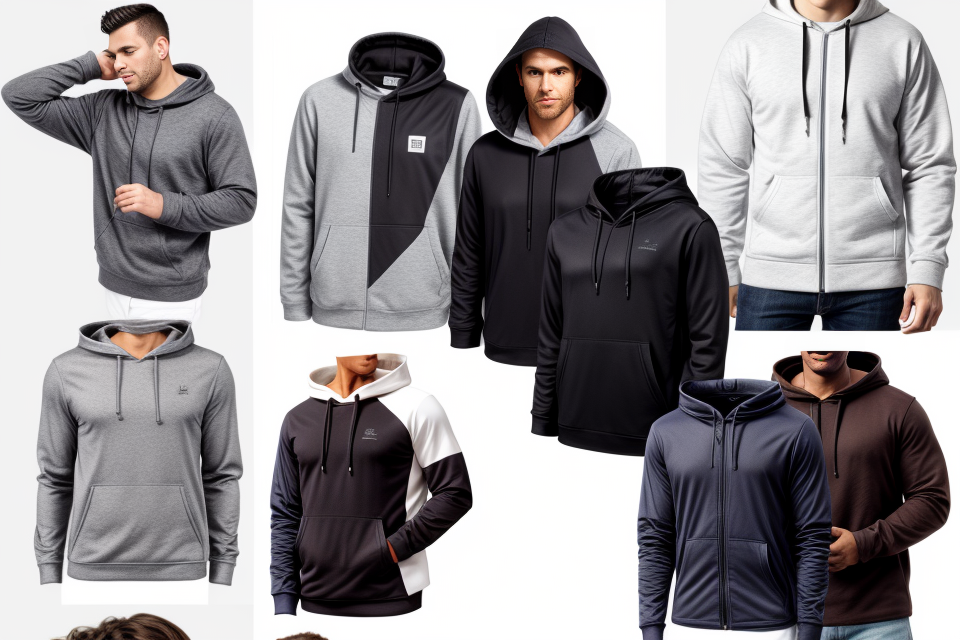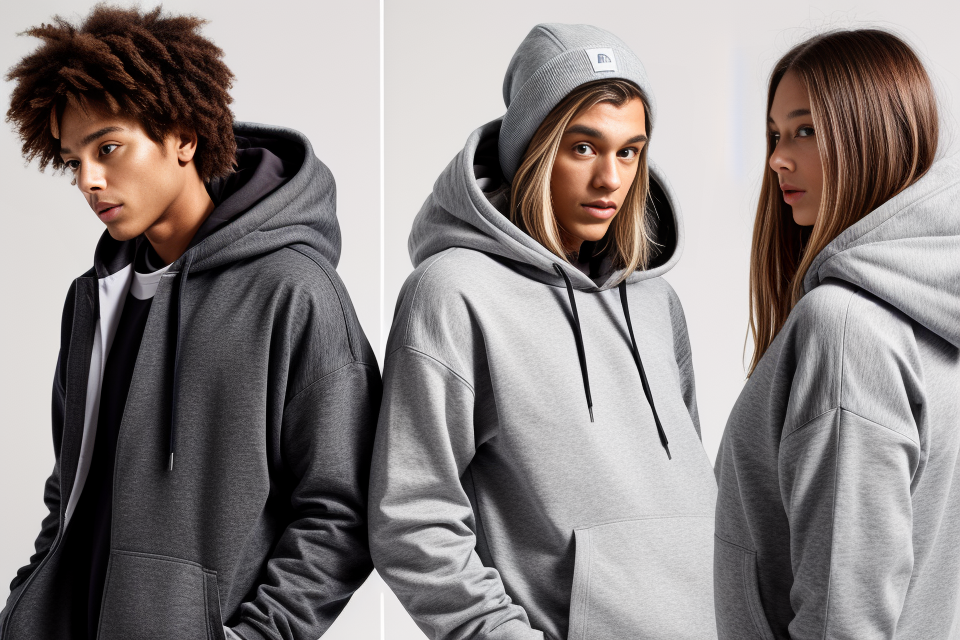
Hoodies are a popular choice of clothing for both men and women, providing comfort and style in equal measure. But when it comes to choosing the fabric for your hoodie, which is the best option? Is 100% cotton the best choice? In this article, we’ll explore the pros and cons of using 100% cotton for hoodies, and help you make an informed decision about what fabric to choose for your next hoodie purchase.
100% cotton is a popular choice for hoodies as it is soft, breathable, and comfortable to wear. However, the best choice ultimately depends on personal preferences and the intended use of the hoodie. Cotton hoodies are good for casual wear and everyday use, but may not be the best choice for activities that require moisture-wicking or insulation, such as outdoor sports or colder climates. Alternative materials like polyester or fleece may be better suited for these situations. Ultimately, it is important to consider factors such as material, price, and intended use when choosing a hoodie.
The Benefits of 100% Cotton Hoodies
Comfort and Softness
When it comes to hoodies, one of the most important factors that people consider is the level of comfort and softness. This is because hoodies are often worn as a casual, everyday garment, and they should be comfortable to wear for extended periods of time. In this section, we will explore the reasons why 100% cotton hoodies are a great choice for those who prioritize comfort and softness.
Natural Fiber Structure
One of the main reasons why 100% cotton hoodies are so comfortable is because of their natural fiber structure. Unlike synthetic materials, which are often made from synthetic fibers that can feel rough or scratchy against the skin, cotton is a natural fiber that is soft and gentle on the skin. The fibers in cotton are also longer and smoother, which means that they are less likely to irritate the skin or cause itching.
Breathability
Another important factor that contributes to the comfort of 100% cotton hoodies is their breathability. Cotton is a highly breathable fabric, which means that it allows air to circulate freely around the body. This is especially important for hoodies, which are often worn as a layering piece under other garments. By allowing air to circulate freely, cotton helps to regulate body temperature and prevent overheating.
Absorbency
Finally, cotton is also an absorbent fabric, which means that it can wick moisture away from the body. This is especially important for hoodies, which are often worn during activities such as exercise or outdoor pursuits. By wicking moisture away from the body, cotton helps to keep the wearer dry and comfortable, even during intense physical activity.
Overall, the combination of natural fiber structure, breathability, and absorbency make 100% cotton hoodies a great choice for those who prioritize comfort and softness. Whether you’re wearing a hoodie as a casual, everyday garment or as a layering piece under other clothing, cotton is sure to provide a comfortable and enjoyable wearing experience.
Durability
- Resistance to wear and tear: 100% cotton hoodies are renowned for their ability to withstand the test of time. The fibers in cotton are naturally strong and durable, which means that your hoodie will be able to resist everyday wear and tear.
- Long-lasting: The longevity of cotton is a result of its natural composition. Unlike synthetic materials, cotton doesn’t lose its shape or quality over time. It can withstand the rigors of daily use and maintain its original form for years to come.
- Easy to care for: Cotton is also a very easy fabric to care for. It can be machine washed and dried without any problems, and it doesn’t require any special treatment to keep it looking new. Additionally, cotton is naturally resistant to wrinkles, which means that your hoodie will always look neat and tidy, even after multiple washes.
Style and Appearance
Versatile
100% cotton hoodies are versatile in nature, making them a popular choice for a wide range of occasions. They can be dressed up for a night out or dressed down for a casual day out. The versatility of cotton hoodies makes them a great investment piece for any wardrobe.
Timeless
Cotton hoodies are a timeless piece of clothing that never goes out of style. They have been a popular choice for decades and continue to be a fashion staple today. Cotton hoodies are classic and effortlessly cool, making them a wardrobe essential for any age group.
Classic Look
The classic look of 100% cotton hoodies is one of the main reasons why they are so popular. They have a simple yet stylish design that can be worn by anyone. The classic look of cotton hoodies is achieved through their basic design, which includes a hood, pocket, and long sleeves. This classic design has remained unchanged for years, making cotton hoodies a timeless fashion piece.
Comparing 100% Cotton to Other Fabrics
Cotton-Polyester Blends
Cotton-polyester blends are a popular alternative to 100% cotton hoodies, as they offer a combination of the natural fibers’ softness and the synthetic fiber’s durability. In this section, we will discuss the pros and cons of cotton-polyester blends, their durability and cost, as well as their appearance and comfort.
Pros and Cons
One of the main advantages of cotton-polyester blends is their increased durability compared to 100% cotton hoodies. Polyester fibers are resistant to wear and tear, making the fabric more long-lasting and less prone to pilling or fading. Additionally, blending cotton with polyester can improve the fabric’s strength and resilience, reducing the risk of ripping or tearing.
However, there are also some drawbacks to consider. Cotton-polyester blends may not be as soft or breathable as 100% cotton hoodies, which could make them less comfortable to wear for some individuals. Moreover, the addition of polyester may affect the fabric’s ability to wick moisture away from the body, potentially leading to increased sweating.
Durability and Cost
In terms of durability, cotton-polyester blends are generally more resistant to wear and tear than 100% cotton hoodies. This means they may last longer and require less frequent replacement, making them a more cost-effective option in the long run.
However, the initial cost of cotton-polyester blends may be higher than that of 100% cotton hoodies, as the production process for blended fabrics is often more complex and requires more specialized equipment. Additionally, the price of cotton-polyester blends can vary depending on the specific ratio of cotton to polyester in the fabric, with higher polyester content generally resulting in a lower cost.
Appearance and Comfort
The appearance of cotton-polyester blends can vary depending on the specific ratio of cotton to polyester in the fabric. A higher cotton content may result in a softer, more natural look, while a higher polyester content may produce a sleeker, more synthetic appearance.
In terms of comfort, cotton-polyester blends may not be as soft or breathable as 100% cotton hoodies, which could make them less comfortable to wear for some individuals. However, the added durability of the blend may make it a more suitable choice for those who require a more robust and long-lasting hoodie.
Synthetic Fabrics
When it comes to choosing the best fabric for hoodies, it’s important to consider synthetic fabrics as well. Synthetic fabrics are made from man-made fibers, such as polyester, nylon, and acrylic. While they may not be as popular as natural fabrics like cotton, they have their own set of advantages and disadvantages.
Pros and Cons
One of the main advantages of synthetic fabrics is their durability. They are resistant to wear and tear, and can withstand more frequent washing and drying without losing their shape or color. Additionally, synthetic fabrics are often more affordable than natural fabrics, making them a popular choice for budget-conscious consumers.
However, synthetic fabrics also have their downsides. They are not as breathable as natural fabrics, which means they can cause you to feel hot and sweaty during hot weather. They also tend to retain odors more easily, which can make them less pleasant to wear over time.
Durability and Breathability
In terms of durability, synthetic fabrics are generally more resistant to tearing and fading than natural fabrics like cotton. However, they may not be as soft to the touch, which can make them less comfortable to wear over time. Additionally, because they don’t breathe as well as natural fabrics, they can cause you to feel hot and sweaty, especially during warmer weather.
Appearance and Comfort
When it comes to appearance and comfort, it really depends on personal preference. Some people find that synthetic fabrics feel more comfortable than natural fabrics, while others prefer the feel of cotton or other natural fibers. Additionally, synthetic fabrics can sometimes look and feel less authentic than natural fabrics, which can be a consideration for those who value a more natural look and feel.
Overall, while synthetic fabrics have their advantages, they may not be the best choice for everyone. It’s important to consider your personal preferences and needs when choosing a fabric for your hoodie, and to consider factors like durability, breathability, and appearance when making your decision.
Organic Cotton
When it comes to choosing the fabric for a hoodie, many people consider organic cotton as an alternative to regular cotton. But what exactly is organic cotton, and is it the best choice for a hoodie?
One of the main advantages of organic cotton is that it is grown without the use of synthetic pesticides and fertilizers. This makes it a more environmentally friendly option compared to regular cotton, which can be heavily reliant on these chemicals. Organic cotton also tends to be softer and more comfortable to wear than regular cotton, which can make for a better hoodie experience.
However, there are also some drawbacks to organic cotton. One of the main disadvantages is that it can be more expensive than regular cotton, which can make it less accessible to some consumers. Additionally, organic cotton can be more difficult to source and produce, which can lead to lower availability compared to regular cotton.
Environmental Impact
While organic cotton may be a more environmentally friendly option than regular cotton, it is still not without its environmental impact. The process of growing and producing organic cotton can still result in significant water usage and soil degradation, and the production of organic cotton can also generate greenhouse gas emissions.
Cost and Availability
As mentioned earlier, organic cotton can be more expensive than regular cotton, which can make it less accessible to some consumers. Additionally, organic cotton may not be as widely available as regular cotton, which can make it more difficult to find.
Overall, while organic cotton has its advantages, it may not be the best choice for everyone. Consumers should carefully consider the pros and cons of organic cotton before making a decision on which fabric to use for their hoodie.
Factors to Consider When Choosing a Hoodie
Climate and Activity
When it comes to choosing a hoodie, the climate and activity level are two important factors to consider. Different materials offer varying levels of insulation, moisture-wicking, and breathability, all of which can impact your comfort and performance in different environments.
- Insulation: The right level of insulation is crucial to keeping you warm in cold weather. 100% cotton hoodies, while cozy, may not provide the necessary insulation for extremely cold temperatures. On the other hand, synthetic materials like polyester and fleece can offer better insulation and are often preferred for colder climates.
- Moisture-wicking: If you’re active and tend to sweat, you’ll want a hoodie that can effectively wick moisture away from your body. While cotton has natural moisture-wicking properties, synthetic materials like polyester and nylon are often more effective at quickly moving sweat away from your skin.
- Breathability: In warmer weather or during high-intensity activities, breathability is key to staying cool and comfortable. Cotton is known for its excellent breathability, but synthetic materials can also offer good ventilation and are often preferred for activities like running or cycling.
Overall, the choice between 100% cotton and other materials for your hoodie will depend on your specific needs and the climate and activity level you’ll be encountering. It’s important to consider these factors when making your decision to ensure maximum comfort and performance.
Budget
When it comes to choosing a hoodie, budget is an important factor to consider. While it may be tempting to opt for the most expensive option, it’s important to balance cost with value for money and longevity.
- Cost: The cost of a hoodie can vary greatly depending on the materials used, the brand, and the style. It’s important to set a budget and stick to it, but also keep in mind that a higher price tag doesn’t always mean a better quality hoodie.
- Value for money: When considering the cost of a hoodie, it’s important to think about the value for money. A hoodie made from high-quality materials that will last for years may be more expensive upfront, but it could end up being a better investment in the long run.
- Longevity: A hoodie that is well made and constructed with high-quality materials can last for years, making it a wise investment. While a cheaper hoodie may seem like a good deal in the moment, it may not last as long and need to be replaced more frequently.
Overall, when considering budget, it’s important to balance cost with value for money and longevity. A hoodie that is well made and constructed with high-quality materials may cost more upfront, but it could end up being a better investment in the long run.
Making the Right Choice for Your Hoodie
Assessing Your Needs
When choosing the right material for your hoodie, it’s important to assess your needs to make an informed decision. Here are some factors to consider:
Climate and activity level
The climate and activity level you’ll be engaging in will play a significant role in determining the best material for your hoodie. If you live in a colder climate or plan to be active in cold weather, you may want to consider materials that provide extra warmth, such as fleece or synthetic blends. On the other hand, if you live in a warmer climate or plan to be active in hot weather, materials that are lightweight and breathable, such as cotton or linen, may be more suitable.
Personal preferences
Your personal preferences should also be taken into account when choosing a material for your hoodie. Do you prefer a softer or rougher texture? A lighter or heavier weight? A looser or more fitted cut? Consider how you want your hoodie to feel and fit, and choose a material that aligns with your preferences.
Budget
Finally, your budget can also play a role in determining the best material for your hoodie. Some materials, such as high-end cashmere or premium down, can be quite expensive. However, there are many affordable options available, such as 100% cotton or synthetic blends, that can still provide durability and comfort.
Exploring Options
When it comes to choosing the right fabric for your hoodie, there are several options available. Each fabric has its own unique properties, which can affect the comfort, durability, and overall performance of your hoodie. Here are some of the most popular options to consider:
- 100% cotton hoodies: These hoodies are made entirely from cotton fibers, which are known for their softness, breathability, and durability. Cotton is a natural fiber that wicks moisture away from the body, making it a great choice for active wear. It is also biodegradable and renewable, making it an eco-friendly option.
- Alternative fabrics and blends: Some hoodies are made from alternative fabrics, such as polyester, nylon, or a blend of both. These fabrics are often used to create hoodies that are designed for specific activities, such as hiking or running. They are typically more resistant to wear and tear than cotton, but may not be as breathable or comfortable.
- Brands and retailers: When choosing a hoodie, it is important to consider the brand and retailer that you purchase from. Some brands are known for using high-quality materials and construction techniques, while others may cut corners to save costs. Similarly, some retailers are known for offering excellent customer service and support, while others may not be as reliable.
Ultimately, the best choice for your hoodie will depend on your personal preferences and needs. Consider factors such as the intended use of the hoodie, your budget, and your priorities when it comes to comfort, durability, and style. By exploring your options and doing your research, you can find the perfect hoodie that meets your needs and fits your lifestyle.
Making a Decision
When it comes to choosing the right material for your hoodie, there are several factors to consider. Ultimately, the decision you make will depend on your personal preferences, needs, and budget. Here are some things to keep in mind when making a decision:
Considering Pros and Cons
One way to make a decision is to weigh the pros and cons of each material. For example, 100% cotton is a popular choice for hoodies because it is soft, breathable, and durable. However, it may also be more expensive than other materials, and it may not be as warm as synthetic fabrics.
On the other hand, synthetic fabrics like polyester and nylon may be more affordable, but they may not be as soft or breathable as cotton. They may also retain more heat, which could be a pro or a con depending on your needs.
Evaluating Value for Money
Another factor to consider is the value for money. While 100% cotton may be more expensive upfront, it may also last longer and wear better over time. On the other hand, synthetic fabrics may be more affordable, but they may not hold up as well to wear and tear.
Trusting Your Instincts
Ultimately, the best choice for your hoodie will depend on your personal preferences and needs. It’s important to trust your instincts and choose a material that feels comfortable and meets your requirements. Whether you opt for 100% cotton, a blend, or a synthetic fabric, the most important thing is that you choose a material that you will enjoy wearing.
FAQs
1. What is 100% cotton?
100% cotton refers to a type of fabric that is made entirely from cotton fibers. Cotton is a natural, breathable, and durable material that is often used to make clothing such as t-shirts, jeans, and hoodies.
2. What are the benefits of 100% cotton hoodies?
There are several benefits to choosing 100% cotton hoodies. Cotton is a natural material that is breathable, comfortable, and durable. It is also a good insulator, which means that it can keep you warm in the winter and cool in the summer. In addition, cotton is a sustainable material that is renewable and biodegradable.
3. Are there any drawbacks to 100% cotton hoodies?
One potential drawback to 100% cotton hoodies is that they may shrink when washed or dried. This can be mitigated by following the care instructions on the label and avoiding high temperatures when washing and drying. Additionally, cotton can be more expensive than other materials, such as synthetic blends.
4. How do I care for 100% cotton hoodies?
To care for your 100% cotton hoodie, it is important to follow the care instructions on the label. In general, cotton should be washed in cold water and hung to dry or tumbled on a low heat setting. Avoid using bleach or fabric softener, as these can weaken the fibers and cause shrinkage.
5. Is 100% cotton the best choice for hoodies?
Whether or not 100% cotton is the best choice for hoodies depends on your personal preferences and needs. Cotton is a good choice for those who want a natural, breathable, and durable material. However, if you are looking for a material that is more affordable or has specific performance characteristics, such as moisture-wicking or odor-resistance, you may want to consider other options, such as synthetic blends or technical fabrics.


